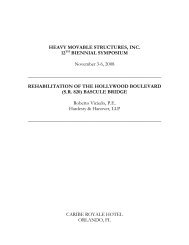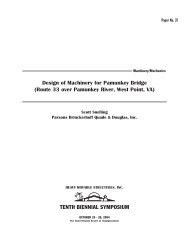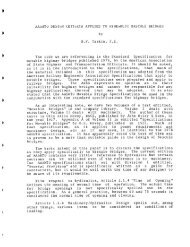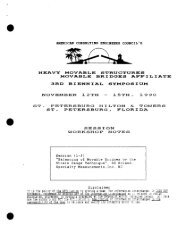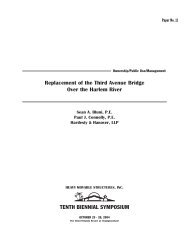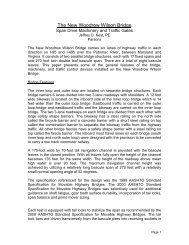Safety in Hydraulic Cylinder Lifting Systems - Heavy Movable ...
Safety in Hydraulic Cylinder Lifting Systems - Heavy Movable ...
Safety in Hydraulic Cylinder Lifting Systems - Heavy Movable ...
You also want an ePaper? Increase the reach of your titles
YUMPU automatically turns print PDFs into web optimized ePapers that Google loves.
if we analyze the requiremenfs for these type of cylrl<strong>in</strong>deas related to the piliars on which the ABS concept is<br />
based we f<strong>in</strong>d the fotloMng:<br />
I Isrfiueneal surround<strong>in</strong>g factors;<br />
Bridges are iocated mostly h coastal or <strong>in</strong>dustrialized areas. This impties that the cyl<strong>in</strong>ders are subjected<br />
to an aggressive or salq en$ro-onment. The exposure to posSb8e air pollulion (Acid ra<strong>in</strong>) or a salt-water<br />
environment demands for high corrosive resistant design solutions.<br />
Funcgona&w of the f<strong>in</strong>ear motor m<strong>in</strong> the hydr~ulic drbe system;<br />
Tpiw3ly the bddge leafs are d&en by a set of Wo or four cyi<strong>in</strong>ders. L should be vesed &at the qi<strong>in</strong>ders<br />
have the capam to lift adlor hold the bpjdge <strong>in</strong> dynamic as wefl as static load skaQons. The position<br />
<strong>in</strong>dicator systems play a key mfe i4~ the safe and adequate control of the bridge ds'ie.<br />
1<br />
s Requirements of the cyl<strong>in</strong>ders as mechaniwl construction element of the total;<br />
As per DIN 397634 fhe hydraulic steeB structures <strong>in</strong> civil eng<strong>in</strong>eer<strong>in</strong>g should be designed for a life%me of 70<br />
years. For the drive system an expected lifegme of 35 years is required. W& dynamic loaded steels<br />
sbudures exceed<strong>in</strong>g a movement rate 0% 10,000 <strong>in</strong> 35 years the design should be based on an <strong>in</strong>%n$e<br />
Iifegme. As bridges fa!! Mh<strong>in</strong> this category the basis for deign of hydwu!ic cyl<strong>in</strong>ders <strong>in</strong> this aappliwgon is an<br />
<strong>in</strong>fr<strong>in</strong>ge Hifetime.<br />
EnvironmnftaI Cond%ions vs. Corrosion Protedion:<br />
Piston rods:<br />
The weakest and wlnerabie element <strong>in</strong> hydraulic cyl<strong>in</strong>ders was twelitionaliy the pidon rod. S<strong>in</strong>ce the<br />
<strong>in</strong>trdoction of the Ceramax coat<strong>in</strong>g <strong>in</strong> 1989 %his belongs to the past. S<strong>in</strong>ce the market <strong>in</strong>Qoduc%on "Classic"<br />
Ceramax is recog~ized as a trend sett<strong>in</strong>g superior piston rod coat<strong>in</strong>g for genera! applicaGons <strong>in</strong> c~rrosbe and<br />
abrasive envjronmenk dh proven track record. Ceramax is an <strong>in</strong>-house Rexroth Hydraudy~ae development.<br />
Well over 10.000 cyi<strong>in</strong>de~ are delweaed Mh Ceramax rod coat<strong>in</strong>g.<br />
In 1998 the possibil9 was created to develop and apply eng<strong>in</strong>eered coagngs for protedon (corrosion)<br />
aga<strong>in</strong>st extreme external <strong>in</strong>fluences based on new spragng techno1ogy as an add%on to the "Classic"<br />
Ceramax.<br />
Fufier developments %is new spwgng bechnsjogy offew, epsglneered coaBngs, total ~~otecGon<br />
aga<strong>in</strong>st extreme chemical attack such as exposure to 13.5% HCL <strong>in</strong> comb<strong>in</strong>ation with 4 5% HF.<br />
This new spragng process is based on the foilo~ng. The "classic" Ceramax is appPied us<strong>in</strong>g a plasma<br />
spray<strong>in</strong>g process. This peasma process is spray<strong>in</strong>g the ceramic matefial M very high temperatures<br />
(approx. 30.000 "GI and relaWely low ve8aW (approx. 2810 rnis). Because of th~ high temperawre only<br />
ceramic matefial is suBabfe because twill not born or oxidize.<br />
Wtfh the new technology the gayer is sprayed us<strong>in</strong>g a jet (dh oxygen and fuel) with relahe Iow<br />
tempratures (approx. 2.500 "C) but a very high velocq {(approx. 2.000 mls). Wfi this spragng<br />
process it is possible to compose an eng<strong>in</strong>eered layer to a speddic task us<strong>in</strong>g carbides {for hardwe=) <strong>in</strong> a<br />
metallic matrix.<br />
fig. 2 New spray<strong>in</strong>g technology<br />
fig. 1 Plasma spray<strong>in</strong>g<br />
I





